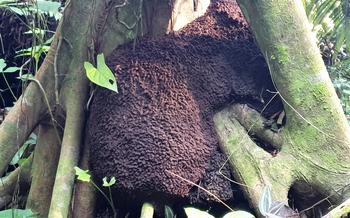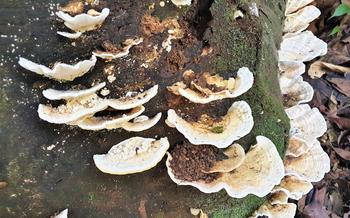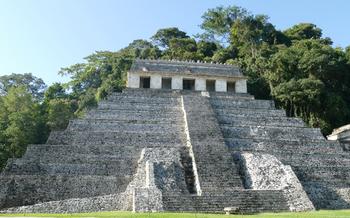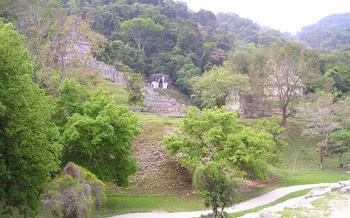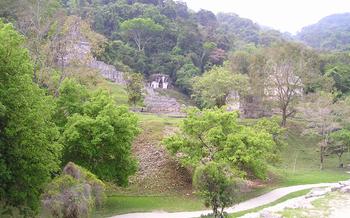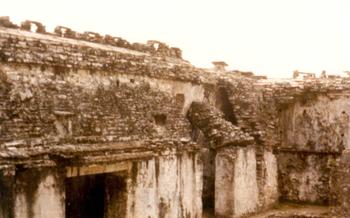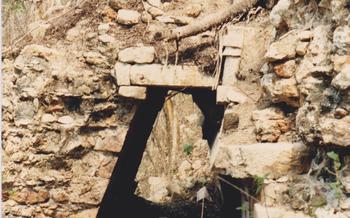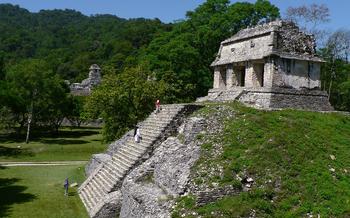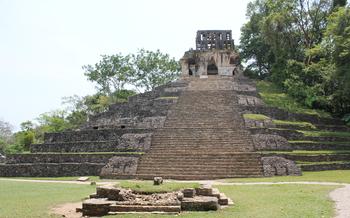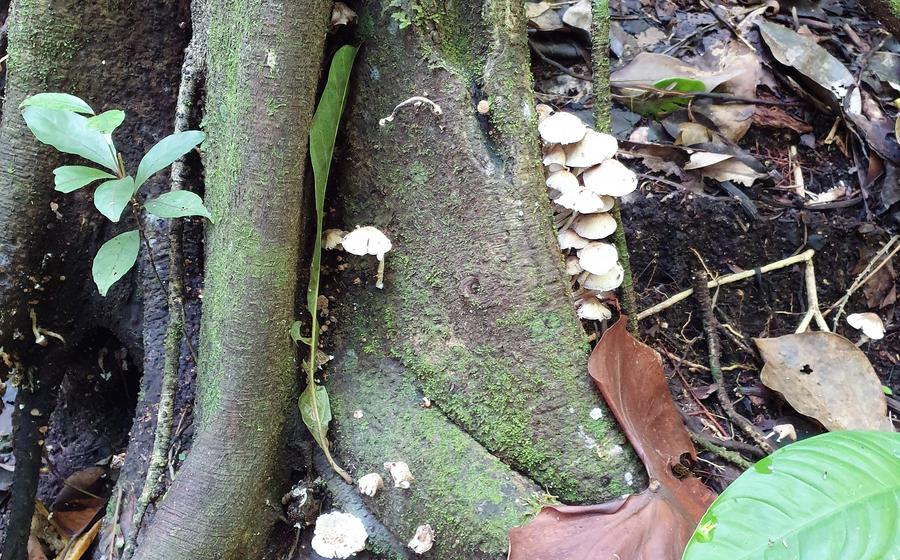
Mirador de Flor de Cacao
- Palenque: An Enchanting Destination
- Mirador de Flor de Cacao: An Overview
- The Journey to the Viewpoint
- Entry and Cost
- The View from the Top
- The Cultural Significance of Flor de Cacao
- The Archaeological Zone: A Journey Through Time
- The Flora and Fauna
- Photography Tips: Capturing the Essence of the Viewpoint
- Souvenirs and Handicrafts
- Safety and Security
- Accessibility for Visitors
- Insider Tip: Unveiling Hidden Gems
Palenque: An Enchanting Destination
Palenque, an ancient Maya city nestled in the heart of the Lacandon Jungle, is a testament to the grandeur and sophistication of the Maya civilization. Its well-preserved ruins, set amidst a backdrop of lush tropical forest, transport visitors to a bygone era of cultural and architectural brilliance. The city played a pivotal role in Maya history, serving as a major political and economic center during the Classic period. Its rich cultural heritage, stunning natural surroundings, and easy accessibility from modern cities make it a must-visit destination for travelers seeking an immersive and awe-inspiring experience.
As I stepped into Palenque, I was immediately captivated by its mystical aura. The city's vibrant atmosphere, friendly locals, and countless attractions beckoned me to explore its wonders. From the moment I arrived, I knew I had stumbled upon a truly special place, where history, nature, and culture intertwined to create an unforgettable tapestry of experiences.
Mirador de Flor de Cacao: An Overview
The Mirador de Flor de Cacao, perched atop a majestic hill overlooking the ancient city of Palenque, offers a breathtaking spectacle that transports visitors to a realm of wonder and awe. The viewpoint, adorned with its evocative name, meaning "Flower of Cacao," pays homage to the sacred significance of cocoa in Palenquean culture.
Beyond its captivating natural beauty, the Mirador de Flor de Cacao carries profound cultural and historical significance. In ancient times, the site served as a sacred ceremonial center, where the Mayans gathered to honor their deities and perform rituals. The viewpoint's elevated position allowed them to commune with the heavens and seek divine guidance.
My personal experience of visiting the viewpoint was nothing short of extraordinary. As I ascended the hill, the anticipation grew with each step. Upon reaching the summit, I was met with a panorama that left me spellbound. The verdant canopy of the rainforest stretched out before me, punctuated by the imposing presence of ancient Mayan structures.
The Mirador de Flor de Cacao is not merely a viewpoint; it is a gateway to a world where history, culture, and nature converge, inviting visitors to delve into the rich tapestry of Palenque's heritage.
The Journey to the Viewpoint
Reaching the Mirador de Flor de Cacao is an adventure in itself, offering a glimpse into the natural beauty of Palenque. Several transportation options are available to suit different preferences and budgets.
For those seeking an immersive experience, embarking on a leisurely hike through the lush rainforest is highly recommended. The journey on foot takes approximately two hours, allowing ample time to appreciate the surrounding flora and fauna. The trail is well-maintained, but sturdy hiking shoes are essential for navigating the uneven terrain.
Alternatively, visitors can opt for a more convenient mode of transport by hiring a local guide with a vehicle. This option ensures a comfortable and direct ride to the viewpoint, typically taking around 30 minutes. Guides often share fascinating insights into the region's history and culture during the journey, enhancing the overall experience.
Regardless of the chosen mode of transport, be sure to set off early to avoid the midday heat and make the most of the cooler morning hours. Carrying sufficient water and snacks is essential, as there are no food or beverage vendors along the way.
Entry and Cost
To enter the Mirador de Flor de Cacao, you'll need to purchase a ticket at the entrance. The fees are quite reasonable, and the viewpoint is open to visitors daily from morning until evening. Guided tours are available for those who prefer a more in-depth experience, led by knowledgeable local guides who can share fascinating insights into the history and significance of the site.
When I visited the viewpoint, I opted for a guided tour, and it was well worth the small additional cost. Our guide, a passionate historian named Carlos, brought the site to life with his captivating stories and explanations. He pointed out key features that I might have missed on my own and provided a deeper understanding of the cultural and historical significance of the viewpoint.
Before your visit, consider purchasing tickets online to save time and avoid queues, especially during peak tourist season. You can find information about ticket prices, hours of operation, and guided tour availability on the official website of the Mirador de Flor de Cacao. Remember to carry your ticket throughout your visit, as you may be asked to show it at various points.
The View from the Top
The ascent to the Mirador de Flor de Cacao is rewarded with a panoramic vista that will leave you breathless. From this elevated vantage point, the verdant tapestry of the Lacandon Jungle unfurls before your eyes, stretching endlessly towards the horizon. The ancient city of Palenque appears diminutive in the distance, its enigmatic ruins nestled amidst the lush vegetation. The Usumacinta River, a vital artery of life, meanders through the landscape, its waters glistening like silver ribbons. In the far distance, the majestic peaks of the Sierra Madre Mountains rise up like silent guardians, their summits shrouded in ethereal mist.
As you gaze upon this awe-inspiring panorama, a profound sense of connection to the natural world washes over you. The symphony of colors, textures, and sounds creates an immersive experience that transcends mere observation. The wind whispers secrets in your ears, carrying the fragrance of exotic flowers and the calls of unseen birds. Time seems to stand still as you soak in the beauty that surrounds you, grateful for the opportunity to witness such a magnificent spectacle.
The Cultural Significance of Flor de Cacao
The Mirador de Flor de Cacao holds immense cultural significance for the people of Palenque, deeply rooted in the history and traditions of the ancient Maya civilization. Cocoa, known as "kakaw" in the Mayan language, played a pivotal role in their culture, serving as a sacred beverage, a form of currency, and a symbol of abundance and fertility.
According to Mayan mythology, the cacao tree originated from the blood of the Maize God, Hun Hunahpu, and was revered as a divine gift. The Flor de Cacao viewpoint was believed to be a sacred site where the Maya performed rituals and ceremonies to honor the cacao tree and its divine origins.
Legends and stories abound, weaving a tapestry of mysticism around the Mirador de Flor de Cacao. One tale speaks of a beautiful princess named Flor de Cacao, who was transformed into a cacao tree to protect her from an evil sorcerer. Her tree bore the most delicious cacao beans, and the Maya believed that by consuming them, they could connect with the divine and receive blessings.
My personal experience at the viewpoint was enriched by learning about these cultural stories. Listening to the local guides narrate the legends brought the ancient Maya civilization to life, infusing my visit with a sense of awe and wonder.
The Archaeological Zone: A Journey Through Time
Just a short walk from the Mirador de Flor de Cacao lies an archaeological zone that offers a glimpse into the rich history of Palenque. These ancient ruins, once part of the thriving Maya city, are a testament to the ingenuity and artistry of this ancient civilization.
The archaeological zone encompasses a series of plazas, temples, and palaces, each with its own unique story to tell. Among the most notable structures is the Temple of the Inscriptions, which houses the tomb of Pakal the Great, one of Palenque's most famous rulers. The temple's intricate carvings and well-preserved hieroglyphics provide valuable insights into the life and reign of this revered king.
Exploring the archaeological zone is an immersive experience that transports visitors back in time. As you wander through the ruins, you can almost feel the presence of the ancient Maya people, who once inhabited these spaces and left behind a legacy that continues to captivate and inspire.
Tips for Exploring the Ruins:
- Allow ample time to explore the archaeological zone, as there is much to see and discover.
- Wear comfortable shoes, as the terrain can be uneven and slippery.
- Bring water and sunscreen, as there is limited shade in the area.
- Consider hiring a guide to provide insights into the history and significance of the ruins.
- Combine your visit to the viewpoint with a guided tour of the archaeological zone for a comprehensive understanding of Palenque's ancient heritage.
Personal Anecdote:
During my visit to Palenque, I spent an entire morning exploring the archaeological zone. I was particularly fascinated by the Temple of the Inscriptions and the intricate carvings that adorned its facade. As I stood before the tomb of Pakal the Great, I couldn't help but feel a sense of awe and wonder at the legacy he left behind. The archaeological zone is a place where history comes alive, and it was an unforgettable experience to walk among the ruins and imagine the bustling city that once stood there.
The Flora and Fauna
The Mirador de Flor de Cacao is not just a cultural and historical site but also a haven for nature lovers. The surrounding area teems with diverse plant and animal species, creating a vibrant ecosystem. The tropical rainforest surrounding the viewpoint is home to a variety of trees, including majestic ceiba trees, towering mahogany, and lush ferns. These trees provide a habitat for a multitude of birds, including colorful parrots, toucans with their distinctive beaks, and melodious songbirds.
Keep an eye out for playful monkeys swinging through the trees and graceful butterflies fluttering their vibrant wings. If you're lucky, you might even spot a glimpse of the elusive jaguar, a symbol of strength and power in Mayan culture. The diverse flora and fauna add to the allure of the Mirador de Flor de Cacao, making it a place where nature and culture harmoniously intertwine.
Remember, while enjoying the wonders of the natural world, it's crucial to respect the delicate ecosystem. Avoid disturbing the wildlife, refrain from littering, and always tread lightly on the land. By doing so, we can preserve the beauty and biodiversity of this unique environment for generations to come.
Photography Tips: Capturing the Essence of the Viewpoint
The Mirador de Flor de Cacao offers a photographer's paradise, with its breathtaking views and diverse landscapes. To capture the essence of this magical place, plan your visit during the golden hours of sunrise or sunset, when the soft light casts a warm glow on the surroundings. Experiment with different camera settings, adjusting the aperture, shutter speed, and ISO to achieve the desired depth of field and exposure. Utilize a wide-angle lens to encompass the panoramic vistas, and a telephoto lens to zoom in on specific details. Don't forget to play with composition, incorporating elements like leading lines, foreground interest, and negative space to create dynamic and visually appealing shots. Embrace the challenge of capturing the vibrant colors of the flora and fauna, as well as the intricate details of the archaeological ruins.
Personal anecdotes:
During my visit, I arrived at the viewpoint just before sunrise, eager to capture the first rays of light illuminating the landscape. As the sky transformed from deep purple to hues of gold and orange, I experimented with different shutter speeds to convey the movement of the clouds and the mist rising from the jungle below. The play of light and shadow created a surreal atmosphere, and I felt a sense of awe as I watched the world come alive before my lens. The intricate carvings on the nearby ruins provided an excellent opportunity to practice my close-up photography skills, revealing the craftsmanship and artistry of the ancient Maya civilization.
Souvenirs and Handicrafts
As you descend from the Mirador de Flor de Cacao, you will likely encounter local vendors selling a variety of souvenirs and handicrafts. These markets are a great place to pick up unique mementos of your visit to Palenque. From colorful textiles and intricate pottery to hand-carved wooden figurines and traditional Mayan clothing, there is something for every taste and budget.
When shopping for souvenirs, be sure to engage with the local artisans and learn about their craft. Bargaining is expected, and it's considered a sign of respect to offer a fair price for their work. By supporting local artisans, you not only take home a piece of Palenque's culture but also contribute to the preservation of traditional skills and livelihoods.
One of my favorite souvenirs from Palenque is a hand-woven hammock that I purchased from a local market. The vibrant colors and intricate patterns remind me of the beauty and craftsmanship of the region. I often use it to relax and unwind, and it always brings back fond memories of my time spent in Palenque.
Safety and Security
When exploring any new destination, safety should always be a top priority. Palenque is generally considered a safe city, but as with any travel destination, it's essential to exercise caution and be aware of your surroundings. The Mirador de Flor de Cacao is situated in a relatively isolated area, so taking the necessary precautions is crucial.
Here are some safety tips to keep in mind:
-
Be aware of your belongings: Keep your valuables close and avoid displaying them unnecessarily.
-
Stay alert: Remain vigilant and avoid distractions that could make you vulnerable to theft or other incidents.
-
Travel in groups: If possible, explore the viewpoint with a companion or group for added safety.
-
Inform your hotel: Let your hotel or tour operator know your plans and expected return time.
-
Avoid venturing out alone at night: The area around the viewpoint is generally safe during the day, but it's best to avoid exploring alone after dark.
-
Be cautious of wildlife: While the wildlife in the area is generally harmless, it's essential to maintain a safe distance and avoid feeding or approaching any animals.
-
Follow the instructions of local authorities: Always follow the instructions and advice provided by local authorities or park rangers to ensure your safety and the preservation of the natural environment.
Accessibility for Visitors
The Mirador de Flor de Cacao is committed to providing an inclusive and accessible experience for all visitors. Individuals with disabilities can access the viewpoint through a designated pathway that leads from the parking area to the observation deck. The pathway is paved and features gentle slopes to ensure a smooth and comfortable journey. Additionally, the observation deck is wheelchair accessible, allowing visitors to enjoy the breathtaking views without any barriers.
To further enhance accessibility, the viewpoint provides wheelchairs for visitors who require assistance. These wheelchairs can be requested at the ticket counter, and a dedicated staff member will be available to assist with their use. Visitors are encouraged to contact the viewpoint in advance if they have specific accessibility needs or concerns. The staff is always ready to accommodate requests and ensure that everyone has an enjoyable and memorable experience at the Mirador de Flor de Cacao.
Personal anecdote:
During my visit to the Mirador de Flor de Cacao, I witnessed firsthand the commitment to accessibility. I met a family with a young child who used a wheelchair, and they were able to navigate the pathway and observation deck with ease. The staff was incredibly helpful, providing them with a wheelchair and assisting them throughout their visit. It was heartwarming to see how the viewpoint had created an environment where everyone could enjoy the beauty and wonder of Palenque's natural and cultural heritage.
Insider Tip: Unveiling Hidden Gems
Beyond the captivating views and cultural significance of the Mirador de Flor de Cacao, there are several hidden gems waiting to be discovered in the vicinity. For those seeking a unique adventure, I highly recommend venturing off the beaten path to explore these lesser-known attractions.
One such gem is the Cascada de Misol-Ha, a mesmerizing waterfall located a short distance from the viewpoint. Take a refreshing dip in its crystal-clear waters, surrounded by lush vegetation and the sounds of nature.
History buffs can delve deeper into Palenque's past at the Museo de Sitio de Palenque, which houses an impressive collection of artifacts from the ancient Maya civilization. Learn about their intricate writing system, advanced mathematical knowledge, and remarkable achievements in art and architecture.
For a taste of local life, visit the Mercado Público de Palenque, a vibrant marketplace where you can immerse yourself in the sights, sounds, and flavors of the city. Browse stalls selling fresh produce, traditional handicrafts, and delicious local delicacies.
Whether you seek adventure, history, or cultural immersion, Palenque offers a wealth of experiences beyond the Mirador de Flor de Cacao. Embrace the opportunity to explore these hidden gems and create lasting memories in this captivating destination.

